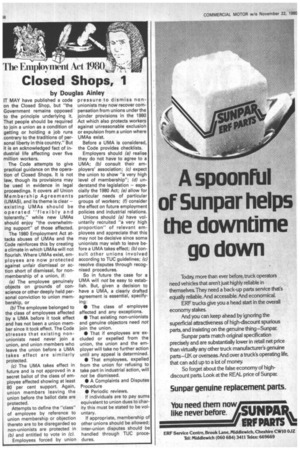Closed Shops,
Page 72

If you've noticed an error in this article please click here to report it so we can fix it.
by Douglas Ainley
IT MAY have published a code on the Closed Shop, but "the Government remains opposed to the principle underlying it. That people should be required to join a union as a condition of getting or holding a job runs contrary to the traditions of personal liberty in this country." But it is an acknowledged fact of industrial life affecting over five million workers.
The Code attempts to give practical guidance on the operation of Closed Shops. It is not law, though its provisions may be used in evidence in legal proceedings. It covers all Union Membership Agreements (UMAS), and its theme is clear — existing UMAs should be operated "flexibly and tolerantly," while new UMAs should enjoy "the overwhelming support" of those affected.
The 1980 Employment Act attacks abuses of UMAs and the Code reinforces this by creating a climate in which UMAs will not flourish. Where UMAs exist, employees are now protected against unfair dismissal or action short of dismissal, for nonmembership of a union, if: (a) The employee genuinely objects on grounds of conscience or other deeply held personal conviction to union membership, or (b) The employee belonged to the class of employees affected by a UMA before it took effect and has not been a union member since it took effect. The Code stresses that existing nonunionists need never join a union, and union members who leave the union before a UMA takes effect are similarly protected.
(c) The UMA takes effect in future and is not approved in a secret ballot of the class of employee affected showing at least 80 per cent support. Again, union members leaving the union before the ballot date are protected.
Attempts to define the "class" of employee by reference to union membership or objection thereto are to be disregarded so non-unionists are protected in (b) and entitled to vote in (c).
Employees forced by union pressure to dismiss nonunionists may now recover compensation from unions under the joinder provisions in the 1980 Act which also protects workers against unreasonable exclusion or expulsion from a union where UMAs exist.
Before a UMA is considered, the Code provides checklists.
Employers should (a) realise they do not have to agree to a UMA; (b) consult their employers' association; (c) expect the union to show "a very high level of membership"; (d) understand the legislation — especially the 1980 Act; (e) allow for particular needs of particular groups of workers; (f) consider the effect on future employment policies and industrial relations.
Unions should (a) have voluntarily recruited "a very high proportion" of relevant employees and appreciate that this may not be decisive since some unionists may wish to leave before a UMA takes effect; (b)consu It other unions involved according to TUC guidelines; (c) resolve disputes through recognised procedures.
So in future the case for a UMA will not be easy to establish. But, given a decision to have a UMA, a clearly drafted agreement is essential, specifying: • The class of employee affected and any exceptions.
• That existing non-unionists and genuine objectors need not join the union.
• That if employees are excluded or expelled from the union, the union and the employer will take no further action until any appeal is determined.
• That employees, expelled from the union for refusing to take part in industrial action, will not be dismissed.
• A Complaints and Disputes Procedure • Periodic reviews.
If individuals are to pay sums equivalent to union dues to charity this must be stated to be voluntary.
If appropriate, membership of other unions should be allowed; inter-union disputes should be handled through TUC procedures.














































































































